LAB REPORT
Science and Technology Making Headlines
Jan. 10, 2020

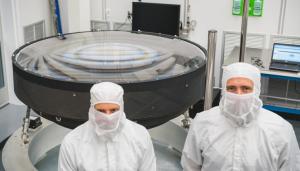
LLNL engineer Vincent Riot (left), who has worked on the Large Synoptic Survey Telescope (LSST) for more than a decade and has been the full camera project manager since 2017, and LLNL optical engineer Justin Wolfe, the LSST camera optics subsystems manager, in front of the LSST main lens assembly. Photo by Farrin Abbott/SLAC National Accelerator Laboratory.
Largest lens goes viral
There are certain items or photos posted on the web that go viral. Last year, one of those stories that made Google Analytics go wild was the gigantic lens made by Lawrence Livermore Natonal Laboratory for the Large Synoptic Survey Telescope (LSST).
The world's biggest photographic lens made some waves. The lens measures 1.57 meters, or 5.1 feet, in diameter and has been designed for use at the LSST, which is being constructed in Chile, where it will be mounted in front a camera with a 3,200-megapixel sensor.
Called L-1, the lens is currently housed at the SLAC National Accelerator Laboratory, which is assembling the super-resolution camera for the telescope. The lens is mounted with a smaller companion lens (1.2 meters / 3.9 feet in diameter) in a carbon fiber structure. Both lenses have been designed by Lawrence Livermore and have been built over the past five years by Boulder, Colorado-based Ball Aerospace and Technologies Corp. and its subcontractor, Tucson-based Arizona Optical Systems.

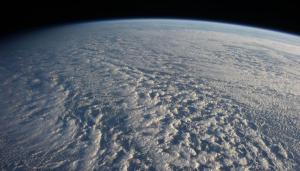
Stratocumulus clouds like these are ubiquitous across global oceans, reflecting sunlight and keeping Earth cooler than it would be otherwise. Global climate models predict that their ability to shade the Earth weakens with global warming. Image courtesy of NASA.
A cloud on the horizon
Researchers at Lawrence Livermore National Laboratory in collaboration with colleagues from the University of Leeds and Imperial College London have found that the latest generation of global climate models predict more warming in response to increasing carbon dioxide than their predecessors.
These refined models represent aspects of Earth’s climate better than previous models, suggesting that these warmer predictions may be more realistic, but more study is needed to establish their reliability.
The researchers analyzed the climate response to an abrupt increase of carbon dioxide in a collection of nearly 30 climate models from around the world. The latest models have wide-ranging sensitivities, but taken as a whole, they warm more than their predecessors by about 0.5 degrees Celsius (0.9 degrees Fahrenheit). Many of them now have sensitivities exceeding 4.5C (8.1F), which is outside the range previously deemed “likely” by the United Nations Intergovernmental Panel on Climate Change (1.5-4.5C, or 2.7-8.1F).
The primary culprits for the increased warming, the team discovered, were clouds.
“Clouds are Earth’s sunscreen, reflecting away sunlight and keeping the planet cooler than it would otherwise be,” explained Mark Zelinka, LLNL climate scientist and lead author of the study.

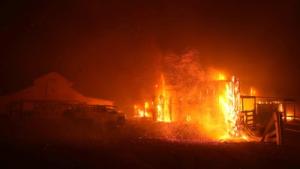
A structure burns from the Kincade fire on Oct. 27, 2019, in Santa Rosa, California. Credit: Justin Sullivan/Getty Images.
UC, Lab team takes on a burning issue
The wildfires that have ravaged California over the past decade are now beginning to affect the state in unexpected ways.
Policymakers, professionals and scientists are working to develop new strategies to prevent and respond to wildfires. Lawrence Livermore National Laboratory and collaborators from UC Santa Barbara, UC San Diego, UC Berkeley and Lawrence Berkeley National Lab will take a comprehensive look at the issues affecting wildfires in a newly awarded $3.3 million project starting this year.
Every year, the UC Lab Fees Program funds a select group of collaborative research projects with money it receives for running two of the nation’s national laboratories. The initiatives selected this year include the new systemic research effort into extreme fire weather, climate change, the electric power grid and vegetation management.
Climate change is clearly affecting extreme fire weather, but it’s doing more than simply raising temperatures. Changing weather patterns are altering the timing and distribution of rain and snow, growing seasons, winds and other aspects of the Earth system.
The scientists will look at how fire weather has been changing over the past 30 years by creating high-resolution datasets and leveraging remote sensing data, historical records and advanced models.

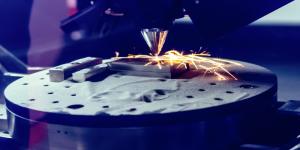
Using a new method of nanofabrication developed at Lawrence Livermore called temporal focusing, engineers were able to produce in about eight minutes a structure with nanoscale features that would have taken several hours with existing two-photon lithography technology.
Focus on faster 3D printing
Lawrence Livermore and Chinese University of Hong Kong researchers have found ways to make 3D printing faster and more cost effective.
Currently, 3D printing operates via a point-by-point scanning fashion, and takes a long time to create an object, with the build rate at about 0.1 millimeters per hour. Even a centimeter-sized object can take several days to weeks to fabricate.
On top of that, there are few solutions to speeding it up without causing problems – if the speed of the current build rates is increased, the resolution of the object being created is compromised. As a result, these 3-D printing processes are impractical for industrial applications, a problem for industries that depend on it to function, make money, etc.
However, researchers have found a way to improve these processes through a concept called temporal focusing. With temporal focusing, “a programmable femtosecond light sheet is formed at the focal plane for parallel nanowriting,” and the 3-D printing processes is “performed in a parallel layer-by-layer fashion instead of point-by-point writing” (which is the current 3-D printing process). Researchers found that aspects of temporal focusing can “fabricate a whole plane within the time that the point-scanning system fabricates a point,” making the process faster – 10,000 times faster (from days to minutes, in some cases), while also improving resolution and decreasing cost (up to 98 percent).

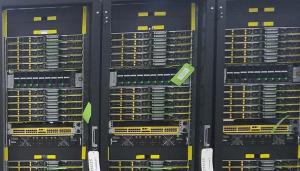
The Corona cluster at LLNL is comprised of AMD EPYC processors, AMD Radeon Instinct GPUs connected with Mellanox HDR 200 Gigabit InfiniBand.
Corona lights up industry
Penguin Computing has upgraded the Corona supercomputer at LLNL with the newest AMD Radeon Instinct MI60 accelerators. Based on the Vega 7 nanometer architecture, this upgrade is the latest example of Penguin Computing and LLNL’s ongoing collaboration aimed at providing additional capabilities to the LLNL user community.
Each Corona compute node is GPU-ready with half of those nodes using four AMD Radeon Instinct MI25 accelerators per node, delivering 4.2 petaFLOPS of FP32 peak performance. With the MI60 upgrade, the cluster increases its potential PFLOPS peak performance to 9.45 petaFLOPS of FP32 peak performance. This brings significantly greater performance and artificial intelligence (AI) capabilities to the research communities.
Corona is being made available to industry through LLNL’s High Performance Computing Innovation Center (HPCIC). The upgrade will help LLNL researchers and their industry partners improve capabilities in scalable deep learning, big data analytics and data science, while enhancing the National Nuclear Security Administration’s ability to assess future architectures and meet the needs of the NNSA’s Advanced Simulation & Computing program.
It also will provide a higher level of performance for researching cognitive computing and developing predictive simulations for applications such as inertial confinement fusion and molecular dynamics simulations for precision medicine.





